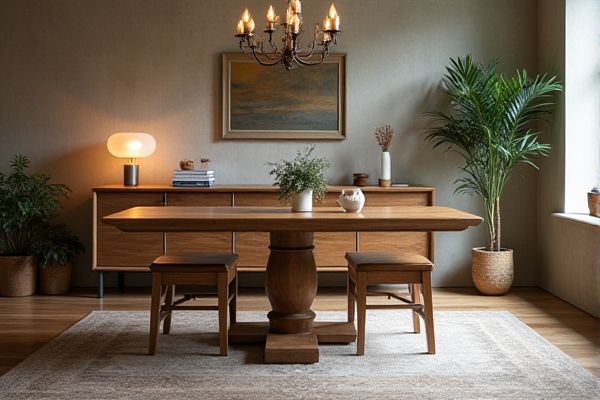
A pedestal table features a single central support, providing ample legroom and a sleek appearance, while a trestle table relies on two or more supports connected by a horizontal beam, offering enhanced stability and rustic charm. Explore the rest of the article to discover which table style best fits Your space and needs.
Table of Comparison
| Feature | Pedestal Table | Trestle Table |
|---|---|---|
| Design | Single central support column | Two or more legs connected by a horizontal beam |
| Stability | Moderate, centered support | Highly stable with wide legbase |
| Legroom | Maximum legroom around edges | Legroom affected by trestle supports |
| Style | Elegant, classic look | Rustic, traditional or industrial look |
| Size | Ideal for smaller to medium tables | Suitable for large or long tables |
| Weight Capacity | Moderate weight support | High weight support, ideal for heavy tops |
| Assembly | Simple with fewer components | Can be more complex with multiple parts |
| Usage | Dining, occasional, or decorative tables | Dining, workbenches, or large workspace tables |
Introduction to Pedestal and Trestle Tables
Pedestal tables typically feature a single central column that supports the tabletop, offering ample legroom and a streamlined design ideal for smaller spaces. Trestle tables are characterized by two or more sturdy supports connected by a horizontal beam, enhancing stability and providing a rustic or traditional aesthetic. Choosing between a pedestal and trestle table depends on the desired style, space efficiency, and durability requirements.
Design Characteristics: Pedestal Table
Pedestal tables feature a central column or single support base, allowing ample legroom and an unobstructed seating arrangement. Their design often includes a round or oval top, emphasizing stability and elegance while maximizing space efficiency. The central pedestal can be crafted from wood, metal, or composite materials, often showcasing decorative detailing or clean, minimalist lines that complement various interior styles.
Design Characteristics: Trestle Table
Trestle tables feature a design characterized by two or more vertical supports, or trestles, connected by a horizontal beam, providing strong stability and ample legroom. The open base design allows easy access from all sides, making trestle tables ideal for dining and workspaces requiring flexibility. Crafted typically from solid wood or metal, the trestle table emphasizes durability and rustic charm, often showcasing exposed joinery and a robust, practical aesthetic.
Material and Construction Differences
Pedestal tables typically feature a single central column made from solid wood or metal, providing strong support and allowing for more legroom around the table. In contrast, trestle tables consist of two or more legs connected by a horizontal beam or stretcher, often constructed from hardwoods like oak or walnut for durability and rustic appearance. The construction of pedestal tables emphasizes a compact support system ideal for smaller spaces, while trestle tables offer enhanced stability and a traditional aesthetic with their wider base and exposed framework.
Aesthetic Appeal and Style Versatility
Pedestal tables offer a sleek, minimalist aesthetic that complements both traditional and contemporary interiors, making them highly versatile in style. Trestle tables, characterized by their sturdy and rustic design, add a charming, farmhouse or industrial vibe to your dining space. Your choice depends on whether you prefer the elegant simplicity of pedestal tables or the robust, casual appeal of trestle tables.
Space Efficiency and Seating Capacity
Pedestal tables feature a single central support, maximizing legroom and allowing more flexible seating arrangements around the table, enhancing space efficiency in smaller rooms. Trestle tables have two or more supports at the ends, which can limit legroom but typically accommodate longer tabletops, providing greater seating capacity for larger gatherings. When prioritizing space efficiency, pedestal tables are ideal for compact areas, while trestle tables excel in maximizing seating capacity in spacious environments.
Stability and Durability Comparison
Pedestal tables feature a single central column that provides moderate stability but can be prone to wobbling under heavy loads or uneven weight distribution. Trestle tables offer superior stability and durability with their dual support beam design, distributing weight evenly and resisting lateral movement more effectively. Your choice should consider the intended use and weight requirements, with trestle tables generally better suited for robust, long-lasting performance.
Ideal Use Cases for Pedestal Tables
Pedestal tables are ideal for small to medium dining spaces where maximizing legroom and seating flexibility is essential. Their central column base allows for easy movement around the table, making them perfect for intimate family dinners or casual gatherings. Ideal settings include kitchens, breakfast nooks, and compact dining areas where space efficiency is a priority.
Ideal Use Cases for Trestle Tables
Trestle tables excel in providing versatile and spacious surfaces, making them ideal for large family gatherings, collaborative workspaces, or crafting projects requiring ample room and easy leg movement. Their sturdy construction supports heavy loads, while the removable or folding trestle bases allow convenient storage and transport, perfect for multi-purpose areas or event setups. You benefit from their adaptability and durability, ensuring a functional centerpiece for dining rooms, studios, or conference rooms.
Choosing the Right Table for Your Space
Pedestal tables offer a central support column, maximizing legroom and making them ideal for smaller spaces or rooms requiring easy movement around the table. Trestle tables feature two or more legs connected by a horizontal support beam, providing sturdy stability and a classic, rustic aesthetic suitable for larger dining areas. Choosing the right table for your space depends on your need for legroom, style preference, and the size of your dining area to ensure comfort and functionality.
 homyna.com
homyna.com